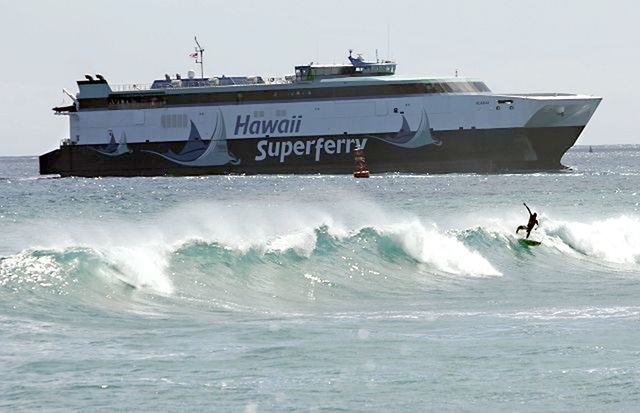Despite a lot of public interest, Hawaii shouldn’t go full speed ahead into a new ferry service, a feasibility study concludes.
Perhaps to no surprise, the report — mandated by the Legislature and published on the state Department of Transportation’s website Monday — says an interisland or intraisland ferry system won’t work without a state subsidy.
But it also cites costs of upgrading piers and ridership projections as reasons for concluding that a state-operated system isn’t “feasible.” The ridership projections didn’t include tourists and conclusions appear to have been based on the most conservative models.
“From a technical standpoint, the lack of available pier space and the significant costs required for constructing new pier facilities to accommodate a ferry system are the primary barrier to feasibility,” says the report produced by consultant SMS Hawaii and the DOT. “From a commercial perspective, the expectations of Hawaii’s residents and the reality of a ferry system are incompatible.”
On the bright side for ferry supporters, the document notes a public-private partnership could be pursued, though that might require further studies. “There may be yet an opportunity to find a feasible ferry solution,” it says.
A survey of stakeholders and the general public favored this model, according to the report. Most respondents say they support a state subsidy.
A public-private model could be similar to the Superferry, a private venture that shutdown in 2009 after a judge ruled it unconstitutional without a full environmental review.
The year-long report, which the Legislature commissioned for $50,000, anticipates criticism for being too conservative or not taking into account tourists. It defends its own analysis by stating a conservative approach is necessary based on past ferry operations and a “fiduciary responsibility to manage the state resources sensibly.”
Based on the surveys, the report notes 62 percent would be willing to pay $140 for an interisland round-trip ticket plus another $90 for a car.
If that was the fare, annual ridership between Honolulu and Hilo was estimated at 60,232 under a “conservative” model, 120,456 under a “realistic” model and 177,333 under an “optimistic” model for a passenger-only ferry. Revenue estimates are $8.4 million, $16.8 million and $24.8 million, respectively.
A passenger and car ferry on that route would see ridership of 63,658, 127,316 or 187,926, based on the same models, and generate approximately the same estimated revenue.
A “financial feasibility analysis” further broke down expenses and revenue for different routes and estimated how much the state would need to subsidize. But this section left out the Hilo-Honolulu option, despite it being one of the most popular in surveys.
Instead, that section looked at two intraisland routes — between Honolulu and Kalaeloa on Oahu, and Lahaina and Maalaea on Maui — and interisland routes from Honolulu to Kahului, and from Maui to Molokai.
Based on conservative models, the report says the state would have to chip in an additional $1.8 million to $34.4 million in the first year, depending on the route, for operating expenses.
A DOT spokesman said in an email that the Hilo route wasn’t included in the financial analysis because the Honolulu-Kahului route had more demand and wasn’t considered feasible.
“The reasoning here was if the financial feasibility did not pencil for the route in highest demand, it would not pencil for any other interisland route,” he said. “… Based on the data from the market study … the revenue and ridership projections for the Honolulu-Hilo or Honolulu-Kawaihae routes are lower than the Honolulu-Kahului route while costs for the Hawaii Island routes are higher as the longer transit times mean doubled fuel costs and higher maintenance expenses.”
The estimated funding gap for a Honolulu-Kahului route would be $5 million in its first year, assuming no federal assistance, according to the report.
Cost of purchasing vessels would be between $10 million and $104 million, depending on the size, and an excess of $100 million could be needed for improving infrastructure.
The report says Hilo Harbor could support a small vessel and a nominal number of parking stalls.
“Radio Bay currently has no infrastructure, but with moderate investment can host an intraisland ferry, or a vessel of under 100 feet in length,” it says. “Any larger operation is highly unlikely as a land acquisition is necessary to create a new yard to stage cars and cargo trucks as they await embarkation.”
Kawaihae Harbor could support an intraisland ferry of a similar size if parking and a passenger facility were made available, the report says.
“With the current cargo volume moving at Kawaihae, Pier 1 is not ideal for a larger ferry operation, but the large coral flats area between the commercial harbor and small boat harbor has potential for development for a ferry,” the document states.
In its analysis, the report did not look at costs of mitigating spread of invasive species, office space or environmental reviews.
Sen. Lorraine Inouye, who chairs the Senate Transportation and Energy Committee, and House Transportation Committee member Rep. Joy San Buenaventura said Monday they had not read the report and couldn’t comment. Both are Big Isle legislators.
To view the report, visit https://tinyurl.com/hawaiiferry.
Email Tom Callis at tcallis@hawaiitribune-herald.com.

